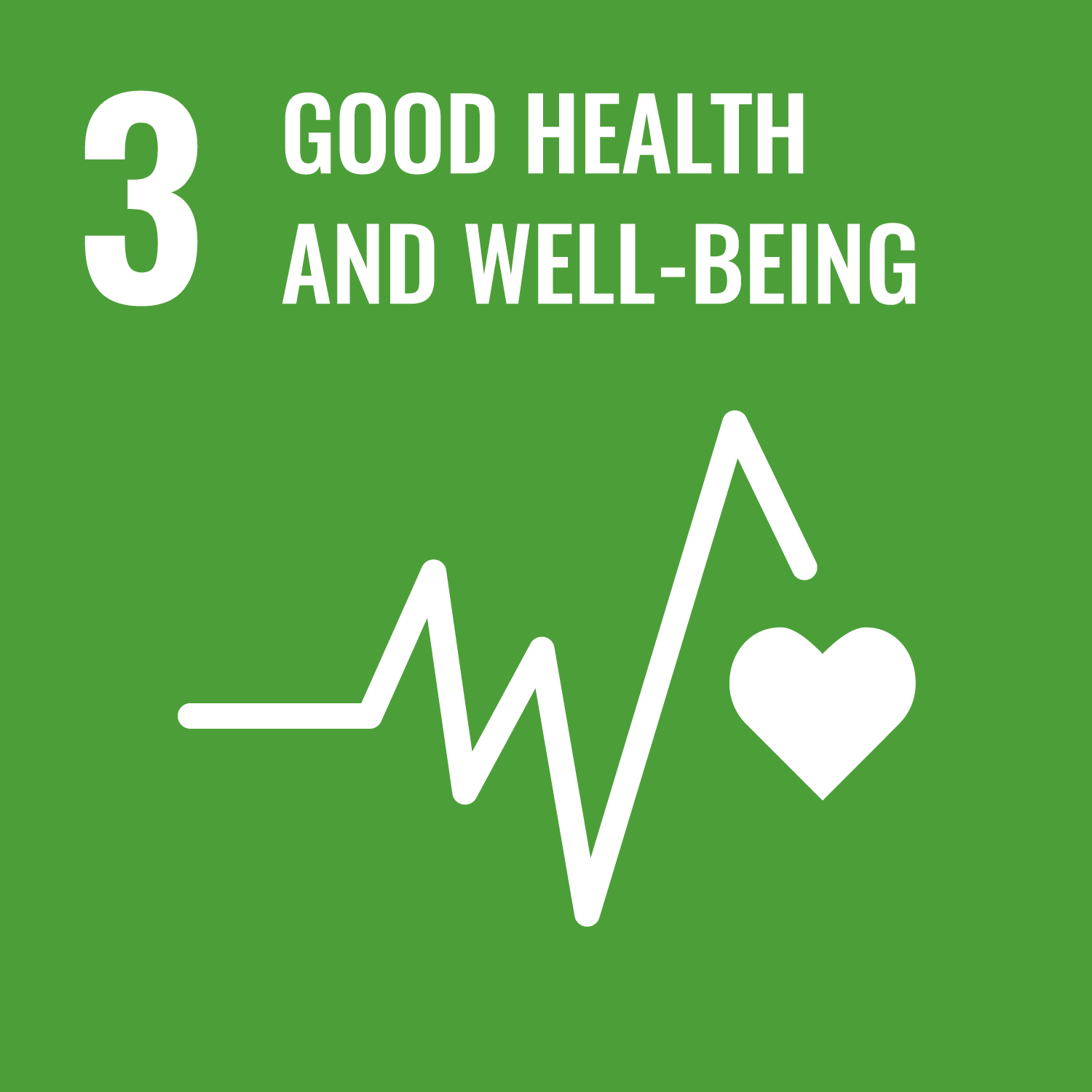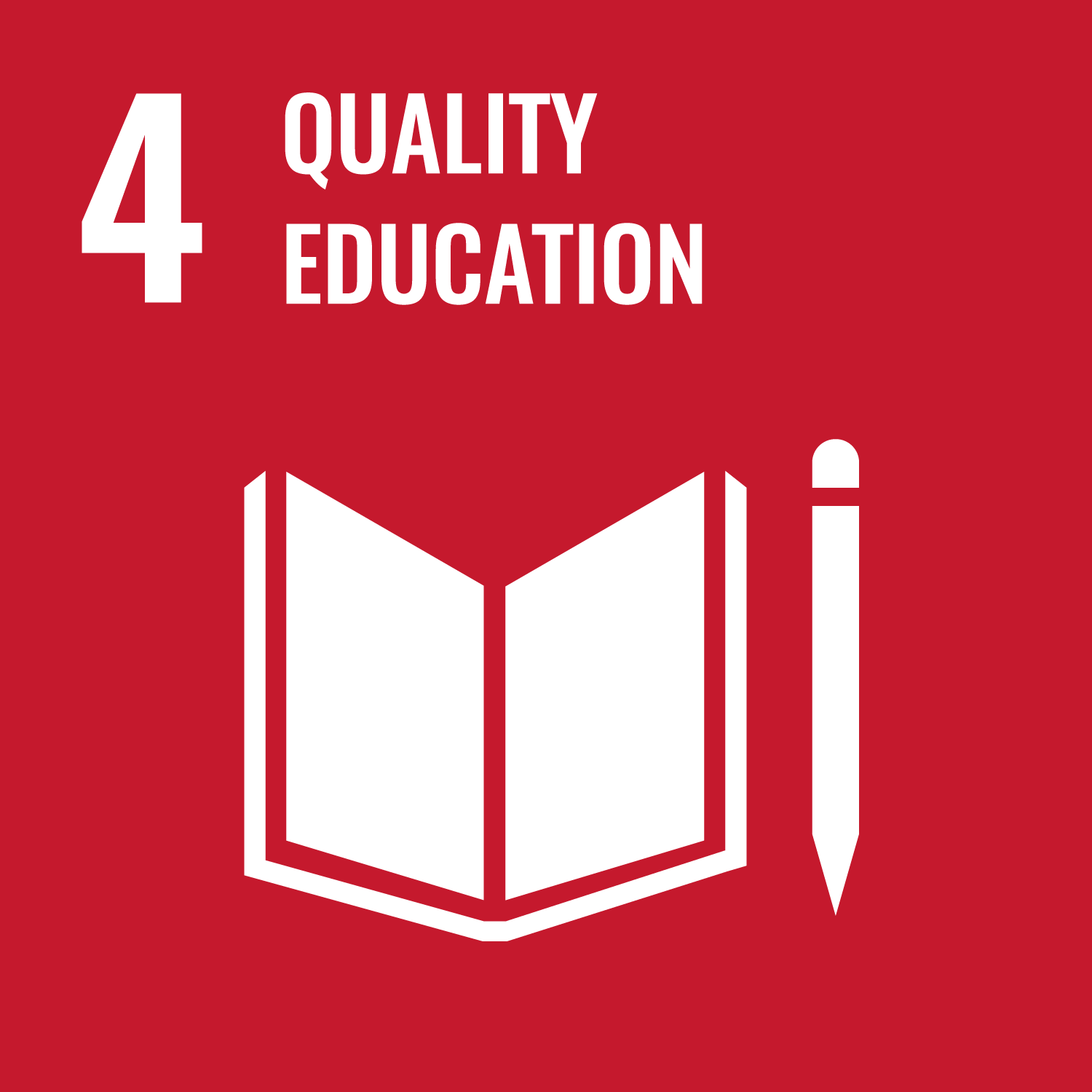Web-Based Pharmacoinformatics Platform for Generic Drug Information in Gorontalo, Indonesia
by Mohamad Aprianto Paneo ★ , Teti Sutriyati Tuloli , Moh Rivai Nakoe , Nikmasari Pakaya , Nurain Thomas , Rifka Anggraini Anggai , Multiani S. Latif
Academic editor: Ernest Domanaanmwi Ganaa
Sciences of Pharmacy 4(4): 215-223 (2025); https://doi.org/10.58920/sciphar0404366
This article is licensed under the Creative Commons Attribution (CC BY) 4.0 International License.
27 May 2025
27 Aug 2025
03 Sep 2025
07 Oct 2025
Abstract: This study aims to evaluate the effectiveness of a web-based drug information application in providing accessible and reliable drug-related information to the public in Gorontalo Province, Indonesia. A prospective, non-randomized study was conducted with 205 participants from the Gorontalo community. Participants completed a structured questionnaire assessing their experience with the "Cari Obatmu" feature on the Ikatan Apoteker Indonesia (IAI) Gorontalo website. The questionnaire covered various aspects such as user interface, search efficiency, clarity of drug indications, side effects, and usability. Descriptive statistics, Cronbach's Alpha for reliability, One-Way ANOVA for demographic differences, and effect size analysis were used in data analysis. The findings indicated high user satisfaction, with mean scores ranging from 4.16 to 4.28 across different aspects assessed. A Cronbach’s Alpha value of 0.975 confirmed excellent internal consistency of the data. The One-Way ANOVA analysis revealed no significant differences in satisfaction scores among demographic groups (p = 0.636), with effect sizes being minimal. The web-based drug information application was well-received, particularly for its functionality and ease of use. However, further improvements are necessary to enhance user experience and feature development. These findings highlight the potential to expand web-based drug information tools to improve public health outcomes in Indonesia, considering the diverse demographic and user needs.
Keywords: Drug InformationWeb ApplicationUser SatisfactionHealth InformaticsUsability Evaluation
Introduction
In Gorontalo Province, Indonesia, there is a significant gap in accessible, comprehensive, and user-friendly platforms that provide detailed information about generic drugs, particularly those adapted to the local language, prescribing practices, and demographic consumption patterns. Considering the unique linguistic context of Gorontalo, the availability of drug information in an understandable language is crucial for patient comprehension. Moreover, aligning drug databases with common prescribing habits and demographic-specific consumption trends ensures that the information provided is both relevant and practical for the local population, thereby improving rational drug use and supporting better health outcomes. This information gap hinders the public’s ability to make informed decisions about medications, which can lead to misuse or underuse of essential drugs, ultimately affecting overall public health outcomes (1-3). Access to accurate and reliable drug information is essential for the proper use of medications, especially for generic drugs, which often serve as more affordable alternatives to branded medications (4, 5). While generic drugs have great potential to improve healthcare accessibility, the lack of clear and accurate information about these drugs remains a challenge in many regions (6, 7).
Recent advances in digital health and health informatics have substantially transformed the way healthcare information is managed and disseminated. Within this context, pharmacoinformatics has emerged as a critical field, integrating pharmacological knowledge with informatics approaches to improve access to accurate, structured, and patient-relevant drug information (8-10). Pharmacoinformatics supports evidence-based decision-making by enhancing the management, analysis, and delivery of drug-related data across healthcare systems (11, 12). When implemented through digital platforms, such as web-based applications, pharmacoinformatics can bridge existing gaps in drug information accessibility, particularly for generic medications, thereby supporting rational drug use and improving public health outcomes..
The integration of pharmacoinformatics into a web-based platform offers a practical solution to address the lack of accessible and reliable information on generic drugs in Gorontalo. Such a platform can provide timely, accurate, and user-friendly drug data, improving public understanding, supporting rational medication use, and enhancing treatment adherence (13-15). By enabling real-time updates that incorporate the latest clinical guidelines and research findings, pharmacoinformatics ensures that healthcare decisions are based on the most current evidence, even in regions with limited health infrastructure (16-20). This study develops and evaluates a web application designed to deliver essential information on generic drugs, aiming to reduce the existing information gap and improve community health outcomes, while offering a scalable model that could be adapted in other regions facing similar challenges.
Methodology
Materials
This study was conducted using the official website of the Ikatan Apoteker Indonesia (IAI) Gorontalo Province, based on the WordPress platform. The study specifically focused on the "Cari Obatmu" feature of the website, which was designed to provide an efficient and user-friendly tool for searching drug-related information. As members of the Indonesian Pharmacists Association (Ikatan Apoteker Indonesia), we frequently hold meetings in the form of workshops discussing the development of medications in Gorontalo. Additionally, as academics from the State University of Gorontalo, we regularly research the profile of drug use in the Gorontalo Province. Through these activities, we have gained a thorough understanding of the availability and usage of medications in Gorontalo. The page offers comprehensive details about commonly used drugs in Gorontalo, including drug indications, dosages, administration instructions, side effects, and available pharmaceutical forms in the market. The drug data used for the application was sourced from credible journals and reliable articles to ensure the accuracy and trustworthiness of the information presented. Indonesian is the main language available in this application. The website’s drug information page can be accessed via the following link: IAI Gorontalo Website.
Study Design
This is a prospective, non-randomized study conducted to evaluate the usability and effectiveness of a web-based drug information application. The study aimed to assess user experiences with the "Cari Obatmu" feature on the Ikatan Apoteker Indonesia (IAI) Gorontalo website. Participants were selected through a purposive sampling method, where 205 community members from Gorontalo were invited to participate based on their familiarity with digital platforms and willingness to engage in the study. The purposive sampling approach was chosen because it allowed for the selection of participants who were likely to be familiar with online applications and able to provide valuable feedback regarding the usability and functionality of the web-based drug information tool.
Participants were required to meet several inclusion criteria. They had to be at least 18 years old to ensure informed consent and maturity in understanding the study process. In addition, participants were expected to possess basic familiarity with digital platforms and have access to the internet, as the study relied on the use of a web-based application. Finally, all participants needed to express their willingness to complete a structured questionnaire that evaluated the usability and effectiveness of the application.
Participants completed a structured questionnaire administered via Google Forms, designed to evaluate various aspects of the application, such as user experience, interface clarity, search efficiency, and the usefulness of the drug information provided. The survey focused on the application’s usability, its ability to meet users’ needs, and the overall satisfaction of the participants. As shown in Figure 1, the data was collected from these 205 respondents to gain insights into the application’s impact. Research ethics approval has been obtained to protect user privacy by submitting a research ethics proposal to the Gorontalo State University Health Research Ethics Committee under number 017B/UN47.B7/KE/2025.
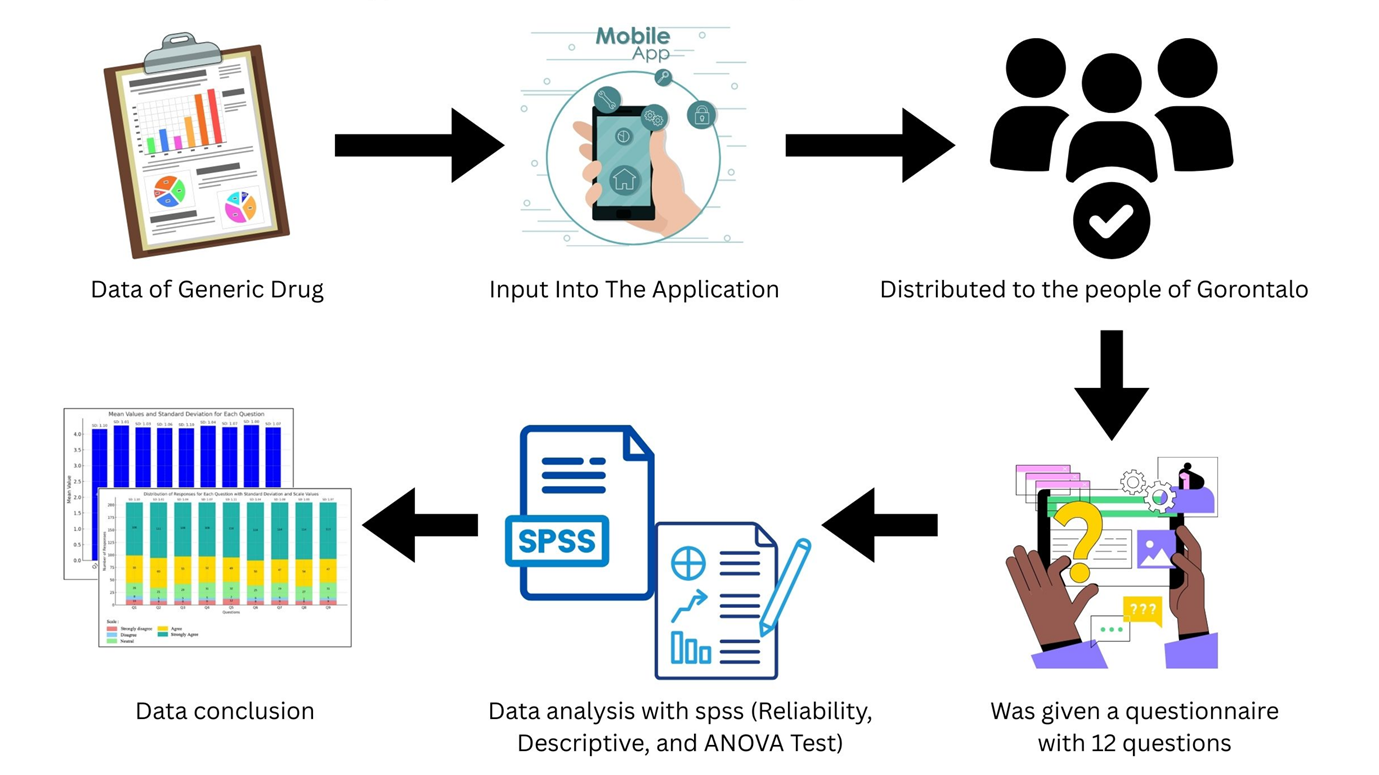
Questionnaire
The questionnaire was designed to collect insights into the participants' experiences with the web application, focusing on its usability, functionality, and the clarity of drug information. It assessed several key aspects: respondent information, including age, gender, and education level; prior experience with drug information applications; and the user interface, particularly how easily participants could understand the application’s display. The questionnaire also examined the search efficiency, determining if participants could quickly find the required drug information. It further evaluated the clarity and speed of locating drug indications, side effects, and dosage information, as well as how easily users could understand the side effects of the drugs. Usability was another area of focus, assessing whether participants could operate the application independently without external assistance. The navigation aspect looked at how easily users could find and click on menu items and buttons. Additionally, the questionnaire addressed whether the application helped prevent errors in drug usage and whether participants could easily find information about the available pharmaceutical forms. Finally, it asked participants if they felt the application required further development to better meet their needs (21-23).
Statistical Methods
The statistical analysis for this study was conducted using SPSS version 30 (Statistical Package for the Social Sciences), a widely used software tool for data processing and statistical analysis. The analysis included several key methods: Descriptive Statistics were used to summarize the participants' demographic data and their responses to the questionnaire. Reliability Analysis, utilizing Cronbach’s Alpha, was conducted to measure the internal consistency of the responses. Additionally, One-Way ANOVA was performed to test for differences in satisfaction scores among different groups. Effect size calculations, including Eta-squared, Epsilon-squared, and Omega-squared, were then used to assess the magnitude of any observed differences. These analyses aimed to evaluate the effectiveness and usability of the web-based drug information application, providing valuable insights into areas that may need further development or improvement (24-26).
Results and Discussion
App Interface
Figure 2 illustrates the user interface of the web-based drug information application. Panel A depicts the initial view, where users can access the medication list, while Panel B provides a detailed view of the selected drug, including information on its indications, dosage, usage instructions, side effects, and pharmaceutical form.
The web-based drug information application was designed to provide users with a user-friendly interface that facilitates easy access to essential drug information. As shown in Figure 2, Panel A presents the initial view of the application, where users can search for medications by name. This view includes a list of commonly used drugs, allowing users to quickly browse and select the drug they are interested in. Panel B displays a more detailed view of theselected drug, providing comprehensive information such as the drug’s indications, recommended dosage, instructions for use, possible side effects, and the available pharmaceutical forms. This layout is intended to enhance the user experience by offering both ease of navigation and the ability to access critical information in an organized, clear, and efficient manner. The combination of these features helps users make informed decisions regarding their medication, promoting better health management.
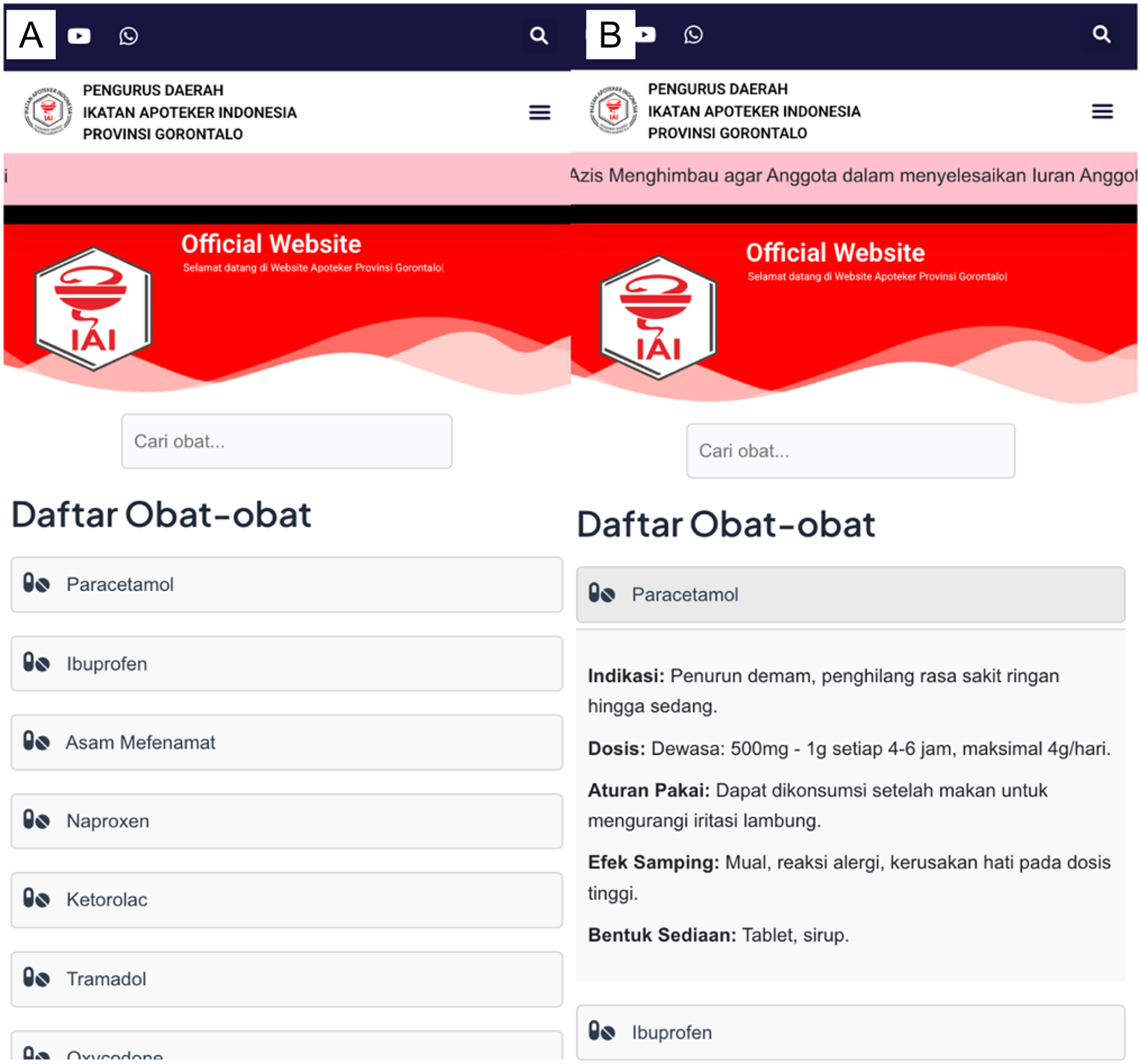
Demographic Profile of Respondents
The demographic profile of the 205 respondents who participated in the survey reveals that a significant portion of participants were under 20 years old (58.5%). This suggests that the web-based drug information application is more frequently accessed by younger individuals, likely due to their greater familiarity with technology and mobile devices. Additionally, 38% of respondents were between 20-35 years of age, indicating that young adults comprise a large segment of the user base (see Figure 3A). This age group is often more proactive in seeking health-related information through digital platforms, which aligns with trends in healthcare technology adoption among younger populations (27-30).
In terms of education, a significant majority of respondents, 69.8%, reported completing high school or its equivalent, indicating that the majority of users have a basic level of education. Furthermore, 19.5% of participants had attained a bachelor’s degree, suggesting that a considerable portion of respondents have access to higher education. This level of education is critical as it may influence both the ability to comprehend drug-related information and the trust placed in the application’s reliability (34-36). Notably, only a small fraction, 5.4%, had completed only elementary or junior high school, indicating that the application’s content is likely designed for an audience with at least some high school-level education (see Figure 3B).
The gender distribution of the survey respondents shows that 69.92% were female, while 37.01% were male. This skew towards females aligns with previous research that suggests women are more likely to engage in health-related activities and seek medical information online. This trend is particularly important for understanding how women interact with digital health technologies and may guide further development to better address the needs of female users (see Figure 4) (31-33). Additionally, gender representation in studies concerning healthcare technology adoption and usage is essential for concluding the effectiveness of these tools across different population groups.
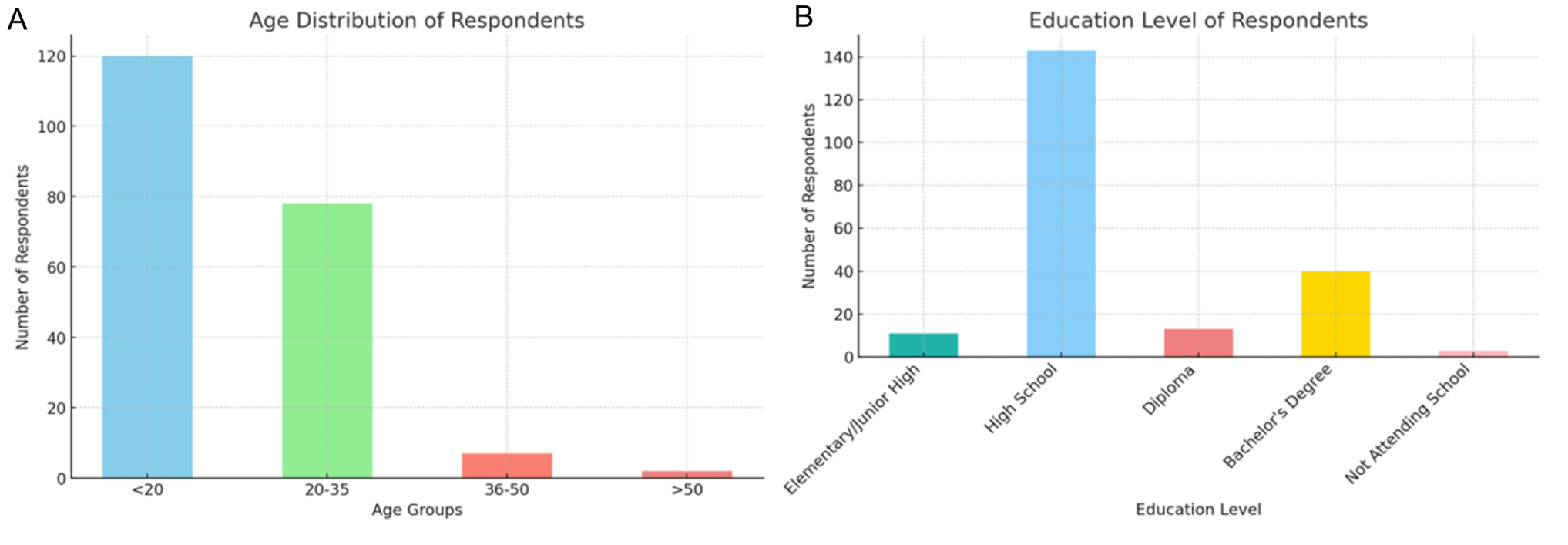
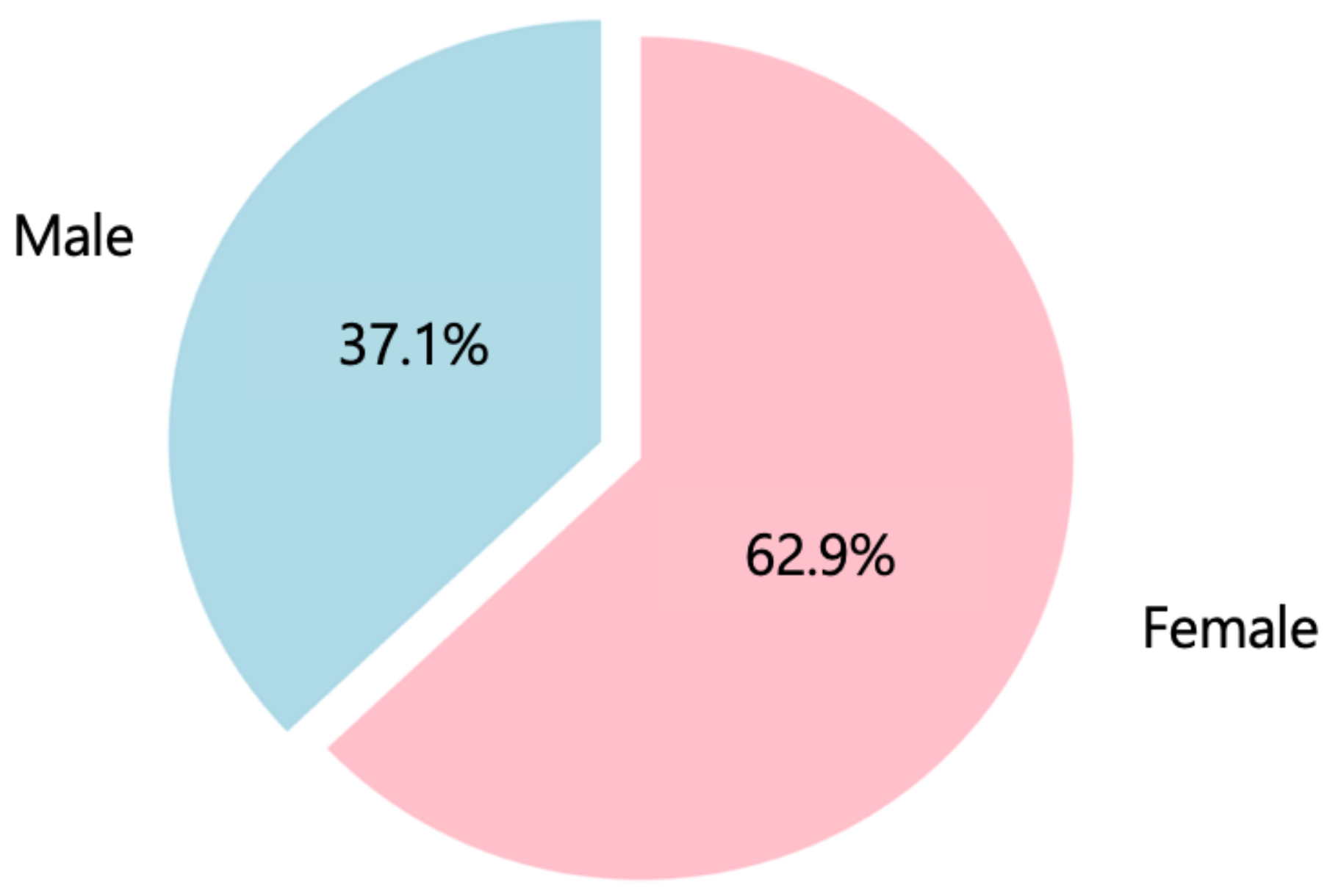
The presence of 3.4% respondents with no formal schooling provides insights into the need for potential improvements in the application's accessibility to users with lower educational backgrounds. This demographic breakdown is crucial for interpreting the survey results and can guide future refinements of the drug information application. The strong representation of young adults and females suggests that the application should be tailored to suit the preferences and needs of this group, while also considering educational factors that may impact how users interact with the app. As the demographic data suggests that most users are relatively educated and familiar with technology, the web-based application may benefit from further enhancing its usability, accessibility, and educational features to cater to a broader and more diverse user base (37-39).
Profile Application-related Questions
The results from Table 1 and Figure 5 provide insights into the respondents' evaluations of the web-based drug information application, specifically focusing on its usability and effectiveness across various dimensions. The data from the 205 respondents were collected using a Likert scale ranging from 1 (Strongly Disagree) to 5 (Strongly Agree), with the results reflecting participants’ level of agreement with several application-related questions. Regarding the ease of understanding the app’s display (Q1), the majority of respondents showed strong agreement, with 106 respondents selecting Strongly Agree (5), suggesting that users generally find the app’s interface user-friendly and intuitive. This is an important aspect, as a clear and easily understandable display is crucial for user retention and effective engagement with the application (40-42). For finding drug information quickly (Q2), 111 respondents strongly agreed that the app facilitated quick access to drug data, while fewer respondents selected the lower scales, indicating that the app is well-received in terms of quick accessibility. Similarly, for finding drug indications (Q3), 108 respondents rated it positively, supporting the app’s efficiency in providing relevant information. The clarity of drug side effect information (Q4) was also favorably rated, with 108 respondents agreeing strongly, reinforcing that the application is effective in providing easily comprehensible information regarding drug side effects, an essential feature for patient safety and decision-making.
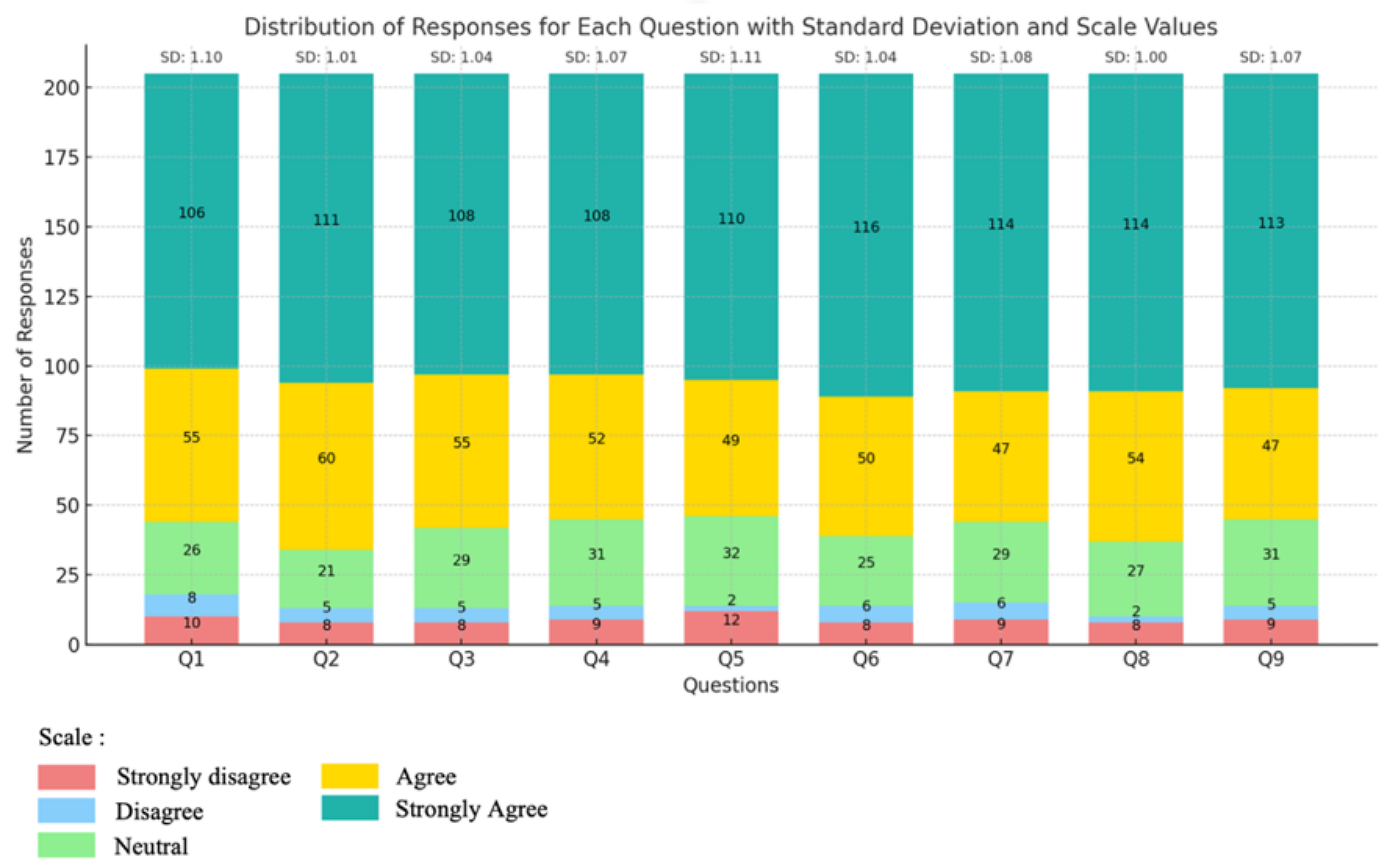
Question | Scale (n=205) | ||||
1 | 2 | 3 | 4 | 5 | |
Is the app display easy to understand? (Q1) | 10 | 8 | 26 | 55 | 106 |
Can I find drug information quickly? (Q2) | 8 | 5 | 21 | 60 | 111 |
Can I quickly find the drug indication? (Q3) | 8 | 5 | 29 | 55 | 108 |
Do I get clear and easy-to-understand drug side effect information? (Q4) | 9 | 5 | 31 | 52 | 108 |
Will I be able to operate this app without the help of others? (Q5) | 12 | 2 | 32 | 49 | 110 |
Are the menus and buttons in this app clearly visible and easy to click? (Q6) | 8 | 6 | 25 | 50 | 116 |
Is the information about drug dosage in this app easy to understand? (Q7) | 9 | 6 | 29 | 47 | 114 |
Does this App help me reduce medication errors? (Q8) | 8 | 2 | 27 | 54 | 114 |
Does this App help me find drug dosage forms? (Q9) | 9 | 5 | 31 | 47 | 113 |
Description:Table 1 shows data expressed Likert scale, 1 (Strongly disagree), 2 (Disagree), 3 (Neutral), 4 (Agree), 5 (Strongly agree). | |||||
On the other hand, the ability to operate the app without assistance (Q5) showed a more mixed response, with a notable 49 respondents selecting the Neutral (3) scale, suggesting that while many found it easy to operate, a portion of users may have experienced some difficulty. This indicates a potential area for improvement in the app’s user interface or instructional support for first-time users.
In terms of the visibility and ease of clicking the menus and buttons (Q6), the app scored highly, with 116 respondents strongly agreeing, indicating that the app’s design facilitates user interaction. This aligns with findings in usability studies where ease of navigation is a key factor in enhancing user experience and satisfaction. For understanding drug dosage information (Q7), similar to the earlier responses, the app was favorably evaluated, with 114 respondents selecting Strongly Agree (5). This result supports the idea that the app effectively communicates critical drug-related data, a vital component for patient safety. The app’s potential to reduce medication errors (Q8) received a relatively positive response, with 114 respondents agreeing. However, this result suggests that while the app is perceived as a helpful tool, further investigation may be needed to confirm its actual impact on reducing medication errors in real-world settings. Similarly, the ability to find drug dosage forms (Q9) was highly rated, with 113 respondents showing strong agreement, suggesting that the app is effective in providing diverse and relevant drug information. In conclusion, the survey results indicate that the web-based drug information application is highly regarded for its ease of use, accessibility, and effectiveness in delivering essential drug information. However, certain areas, such as the need for more intuitive features to help users operate the app without assistance, and enhancing the impact on reducing medication errors, could benefit from further refinement. These findings provide valuable feedback for future iterations of the application, which can enhance both its usability and overall impact on improving healthcare outcomes (40, 42, 43).
Reliability Test
The reliability test results for the 205 respondents were assessed using Cronbach’s Alpha, which measures the internal consistency of the scale. With a value of 0.975, Cronbach’s Alpha indicates excellent internal consistency, suggesting that the scale items are highly correlated and effectively measure a single underlying construct. This level of reliability is considered excellent, as values above 0.7 are generally accepted as indicating acceptable reliability, according to established guidelines for Cronbach’s Alpha.
The scale consists of 9 items, with a mean score of 38.0390, which reflects the central tendency of the responses, indicating that respondents generally agreed with the statements in the questionnaire. The scale variance of 75.763 shows the extent of variability in responses, while the standard deviation (SD) of 8.70420 further emphasizes the spread or dispersion of responses across the sample. These results confirm that the scale not only has high internal consistency but also provides a good spread of responses across the range of the Likert scale used. In conclusion, the high Cronbach's Alpha and supportive statistics regarding the scale's mean, variance, and standard deviation suggest that the instrument used in this study is both reliable and effective for capturing user feedback on the web-based drug information application (44). This reliability further strengthens the validity of the findings derived from the application’s evaluation, supporting the use of the scale in assessing its functionality and usability.
Frequency Statistic
Table 2 displays the frequency statistics for the 205 survey responses, offering an overview of the participants' evaluations of the web-based drug information application. The mean values for all nine questions range from 4.16 to 4.28, indicating general agreement with the statements presented in the survey. These values suggest that users are largely satisfied with the application’s usability, ease of understanding, and the relevance of the drug information it provides. The median and mode values for each question are consistently 5.0, signifying a strong tendency toward the highest level of agreement, Strongly Agree (Scale 5), across all survey items. This uniformity in responses underscores the overall positive reception of the app, with respondents indicating that they found the app easy to understand and operate, and that the drug information it provides is helpful (45, 46).
The standard deviation (SD) values for the survey questions range from 1.00 to 1.10, reflecting moderate variability in the responses. This suggests that while there is a strong consensus among respondents regarding the application's functionality, some individuals exhibited slight variations in their opinions. The relatively low standard deviations indicate that the application is broadly perceived positively, with only minor differences in how users rate various features of the app. The minimum and maximum values across all questions are 1.00 and 5.00, respectively, indicating that participants provided the full range of responses (from Strongly Disagree to Strongly Agree), further emphasizing the robustness of the survey data. In conclusion, the survey results suggest that the web-based drug information application is generally well-received by its users. The consistency in the mean, median, and mode values highlights a strong tendency toward positive evaluations, while the moderate variability in responses (indicated by standard deviation) suggests room for fine-tuning to address diverse user experiences. These insights are valuable for future development, ensuring that the application remains user-centric and effectively meets the needs of its audience.
Statistic | Q1 | Q2 | Q3 | Q4 | Q5 | Q6 | Q7 | Q8 | Q9 |
N (Valid) | 205 | 205 | 205 | 205 | 205 | 205 | 205 | 205 | 205 |
Missing | 0 | 0 | 0 | 0 | 0 | 0 | 0 | 0 | 0 |
Mean | 4.16 | 4.27 | 4.21 | 4.19 | 4.18 | 4.26 | 4.22 | 4.28 | 4.21 |
Median | 5.0 | 5.0 | 5.0 | 5.0 | 5.0 | 5.0 | 5.0 | 5.0 | 5.0 |
Mode | 5.00 | 5.00 | 5.00 | 5.00 | 5.00 | 5.00 | 5.00 | 5.00 | 5.00 |
Std. Deviation | 1.10 | 1.01 | 1.03 | 1.06 | 1.10 | 1.04 | 1.07 | 1.00 | 1.07 |
Minimum | 1.00 | 1.00 | 1.00 | 1.00 | 1.00 | 1.00 | 1.00 | 1.00 | 1.00 |
Maximum | 5.00 | 5.00 | 5.00 | 5.00 | 5.00 | 5.00 | 5.00 | 5.00 | 5.00 |
Sum | 854.0 | 876.0 | 865.0 | 860.0 | 858.0 | 875.0 | 866.0 | 879.0 | 865.0 |
Description: Q = question. Table 2 shows the frequency statistics for the 205 survey responses. The mean values range from 4.16 to 4.28, indicating general agreement with the statements. The median and mode are consistently 5.00, suggesting a strong tendency towards "Strongly Agree." Standard deviations range from 1.00 to 1.10, showing moderate variability in responses, with the full range of answers (1-5) selected. | |||||||||
ANOVA One-Way Test
A One-Way ANOVA test was performed to evaluate whether satisfaction scores differed significantly across demographic groups. The results showed no significant differences (p = 0.636), suggesting that user satisfaction was consistent across different age, gender, and education groups. This lack of variability could be attributed to several factors, such as the overall user-friendliness of the application, which may be universally appreciated regardless of demographic differences. Additionally, it is possible that the survey questions were broad enough to capture general usability aspects, which were positively rated by most users, leading to consistent satisfaction scores across groups.
Furthermore, the effect size statistics in Table 3 provide additional insight into the magnitude of the observed differences. The Eta-squared value is 0.008, and the Epsilon-squared and Omega-squared values are -0.006, both of which indicate very small effect sizes. This suggests that the independent variables tested in the ANOVA have a minimal impact on the satisfaction scores. The 95% Confidence Intervals for the effect size statistics (ranging from 0.000 to 0.035 for Eta-squared) further support the conclusion that the independent variables contribute very little to the variation in the satisfaction scores.
These findings suggest that while the satisfaction scores from different groups may vary, the factors tested do not have a meaningful or significant effect on the overall satisfaction with the web-based drug information application. The small effect sizes and lack of statistical significance indicate that other factors, not captured in this study, may be influencing user satisfaction. This underscores the need for further investigation into other potential variables that could play a larger role in shaping users' satisfaction with the application (47, 48).
Despite the overall positive reception, several usability issues were identified that may affect the application's accessibility. A key issue is the difficulty some users face in navigating the app without external help. This was particularly noted by participants who had limited experience with digital platforms. A suggestion for improvement would be to introduce an interactive tutorial or onboarding process for first-time users to guide them through the application’s features. Moreover, enhancing the app’s search algorithm to deliver more accurate and faster results could address concerns raised by users about searching for drug information more efficiently. When compared to similar applications, it may be necessary to add several features, such as AI integration, to this website.
Conclusion
The application shows strong user satisfaction (mean scores ranging from 4.16 to 4.28), but improvements are needed in navigation and search efficiency. ANOVA results indicated no significant demographic differences in satisfaction (p = 0.636), suggesting universal appeal. Future enhancements should include an interactive onboarding process, better search algorithms, and AI-driven recommendations. Scaling to other regions could be achieved by incorporating multilingual support, local drug information, and addressing diverse literacy levels. Expanding features like medication reminders would further enhance user engagement and improve health outcomes.
Declarations
Acknowledgment
I would like to express my sincere gratitude to all the individuals who have contributed to the completion of this research. My deepest appreciation goes to the students of the Diploma 3 Program in the Department of Pharmacy, Faculty of Sports and Health, Universitas Negeri Gorontalo, for their invaluable assistance and support throughout the course of this study. Their dedication, effort, and cooperation have significantly contributed to the successful completion of this research. I also extend my thanks to all those who have provided guidance, encouragement, and resources that were essential for this research
Ethics Statement
This research has been approved by the health research ethics commission (KEPK) of Gorontalo State University with number 017B/UN47.B7/KE/2025 on April 14, 2025.
Data Availability
The unpublished data is available upon request to the corresponding author.
Funding Information
The author(s) declare that no financial support was received for the research, authorship, and/or publication of this article.
Conflict of Interest
The authors declare no conflicting interest.
References
- Chatterjee A. Research & Reviews: Journal of Hospital and Clinical Pharmacy. Citeseer [Internet]. 2016;2(2):85–6.
- J YH, Kulkarni GS, Shetty A, Paarakh PM. Technologies in the Pharmaceutical Industries and Medical Health Care. Int J Inf Technol Comput Eng. 2022;(26):28–38.
- van der Lee M, Swen JJ. Artificial intelligence in pharmacology research and practice. Clin Transl Sci. 2023;16(1):31–6.
- Ma C, Wong Smith H, Chu C, Taira Juarez D. Big data in pharmacy practice: current use, challenges, and the future. Integr Pharm Res Pract. 2015;91.
- Del Rio-Bermudez C, Medrano IH, Yebes L, Poveda JL. Towards a symbiotic relationship between big data, artificial intelligence, and hospital pharmacy. J Pharm Policy Pract. 2020;13(1):4–9.
- Park T, Muzumdar J, Kim HM. Digital Health Interventions by Clinical Pharmacists: A Systematic Review. Int J Environ Res Public Health. 2022;19(1).
- Blumenberg C, Peiris D, de Mola CL, Sinnadurai M, Tian M, Beleigoli AM, et al. Going digital: opportunities and barriers in the use of technology for health research. Salud Publica Mex. 2022;64:22–30.
- Dunne SS, Cummins NM, Hannigan A, Shannon B, Dunne C, Cullen W. Generic medicines: An evaluation of the accuracy and accessibility of information available on the internet. BMC Med Inform Decis Mak. 2013;13(1):1–13.
- Kaplan WA, Wirtz VJ. A research agenda to promote affordable and quality assured medicines. J Pharm Policy Pract. 2014;7(1):2–4.
- Tapan Kumar Mahato, Durgeshwari Raulji. Present scenario of generic medicines in India: A comparative study. World J Biol Pharm Heal Sci. 2021;7(2):053–9.
- Harrison MA, Marfo AFA, Annan A, Ankrah DNA. Access to cardiovascular medicines in low- and middle-income countries: a mini review. Glob Heal Res Policy [Internet]. 2023;8(1).
- Al Ali L, Jagal J, Joseph J, Ahmed IS, Rawas-Qalaji M. Pharmaceutical equivalency of locally and regionally manufactured generic pharmaceutical products in UAE. Saudi Pharm J [Internet]. 2022;30(9):1243–51.
- John SE, Channanath AM, Hebbar P, Nizam R, Thanaraj TA, Al-Mulla F. Pharmaku: A web-based tool aimed at improving outreach and clinical utility of pharmacogenomics. J Pers Med. 2021;11(3).
- Liu S, Wang X, Zhao X, Chen H. DKINet: Medication Recommendation via Domain Knowledge Informed Deep Learning. 2023;1–11.
- Aremu TO, Oluwole OE, Adeyinka KO, Schommer JC. Medication Adherence and Compliance: Recipe for Improving Patient Outcomes. Pharmacy. 2022;10(5):106.
- Kilova K, Mihaylova A, Peikova L. Opportunities of information communication technologies for providing pharmaceutical care in the COVID-19 pandemic. Pharmacia. 2021;68(1):9–14.
- Darrow JJ, Borisova E. Communication of Drug Efficacy Information via a Popular Online Platform. J Am Board Fam Med. 2022;35(4):833–5.
- Sikandar H, Abbas AF, Khan N, Qureshi MI. Digital Technologies in Healthcare: A Systematic Review and Bibliometric Analysis. Int J online Biomed Eng. 2022;18(8):34–48.
- Khatiwada AP, Shakya S, Shrestha S. Paradigm shift of drug information centers during the COVID-19 pandemic. Drugs Ther Perspect. 2020;36(9):389–95.
- Chandola A, . R, Kandari S, Joshi Y. Status of Drug Information Centre and Services in India: An Overview and Challenges. Int J Pharm Sci Rev Res. 2020;64(2):60–4.
- Giovannoni G, Alvarez E, Tutton E, Hoffmann O, Xu Y, Vermersch P, et al. Development and usability testing of your MS questionnaire: A patient-based digital tool to monitor symptoms of multiple sclerosis. Digit Heal. 2023;9.
- Bergmo TS, Sandsdalen V, Manskow US, Småbrekke L, Waaseth M. Internet Use for Obtaining Medicine Information: Cross-sectional Survey. JMIR Form Res. 2023;7.
- Katernyak I, Nikolaiev. User Experience Research Using a Web-Application Ux-Questionnaire. Electron Inf Technol. 2023;21(21):57–63.
- Sharma LR, Jha S. Applying Major Parametric Tests Using SPSS in Research. Int Res J MMC. 2023;4(2):85–97.
- Wang A, Anderson-Bialis J, Morris JR, Corley J, Anderson-Bialis D, Citro L, et al. Racial and ethnic differences in self-reported satisfaction with fertility clinics and doctors. Arch Gynecol Obstet. 2023;308(1):239–53.
- Jovanovic D, Jankovic J, Mirilovic N. Socio-demographic inequalities in satisfaction with primary health care and utilization of chosen doctors’ services: A cross-sectional study. South East Eur J Public Heal. 2020;13(February):1–12.
- Skouteris H, Savaglio M. The use of social media for preconception information and pregnancy planning among young women. J Clin Med. 2021;10(9).
- Frishammar J, Essén A, Simms C, Edblad R, Hardebro V. Older Individuals and Digital Healthcare Platforms: Usage Motivations and the Impact of Age on Postadoption Usage Patterns. IEEE Trans Eng Manag. 2023;70(8):2903–19.
- Raeside R, Jia SS, Redfern J, Partridge SR. Navigating the Online World of Lifestyle Health Information: Qualitative Study With Adolescents. JMIR Pediatr Parent. 2022;5(1).
- Lim MSC, Molenaar A, Brennan L, Reid M, McCaffrey T. Young Adults’ Use of Different Social Media Platforms for Health Information: Insights From Web-Based Conversations. J Med Internet Res. 2022;24(1).
- Walker RE, Quong S, Olivier P, Wu L, Xie J, Boyle J. Understanding Preconception Women’s Needs and Preferences for Digital Health Resources: Qualitative Study. JMIR Form Res. 2022;6(8).
- Ozen H. Gender Difference in eHealth Literacy: Empirical Evidence from Turkey. Int J Acad Res Bus Soc Sci. 2021;11(4):1058–68.
- Hiebert B, Hall J, Donelle L, Facca D, Jackson K, Stoyanovich E. “Let me know when I’m needed”: Exploring the gendered nature of digital technology use for health information seeking during the transition to parenting. Digit Heal. 2021;7.
- Robert Sabaté L, Diego L. Are we offering patients the right medicines information? A retrospective evaluation of readability and quality in online patient drug information. Eur J Hosp Pharm. 2021;28(3):144–8.
- Kim M, Suh D, Barone JA, Jung SY, Wu W, Suh DC. Health Literacy Level and Comprehension of Prescription and Nonprescription Drug Information. Int J Environ Res Public Health. 2022;19(11).
- Qvarfordt M, Throfast V, Petersson G, Hammar T, Hellström L. Web-based education of the elderly improves drug utilization literacy: A randomized controlled trial. Health Informatics J. 2021;27(1).
- Monkman H, Kushniruk A, Borycki E, Sheets D, Barnett J, Nøhr C. The medium is the message: How do canadian university students want digital medication information? Life. 2020;10(12):1–16.
- Jennifer Wong YC, Lee C, Virani A. Survey of drug information database preferences among staff from selected British Columbia health authorities. Can J Hosp Pharm. 2020;73(4):257–65.
- Agaku I, Odani S, Nelson J. Medical use and misuse of psychoactive prescription medications among US youth and young adults. Fam Med Community Heal. 2021;9(1):1–17.
- Kim JC, Saguna S, Åhlund C. Acceptability of a Health Care App With 3 User Interfaces for Older Adults and Their Caregivers: Design and Evaluation Study. JMIR Hum Factors. 2023;10.
- Perrig SAC, Ueffing D, Opwis K, Brühlmann F. Smartphone app aesthetics influence users’ experience and performance. Front Psychol. 2023;14.
- Tajudeen FP, Bahar N, Tan MP, Peer Mustafa MB, Saedon NI, Jesudass J. Understanding User Requirements for a Senior-Friendly Mobile Health Application. Geriatr. 2022;7(5):1–21.
- Zhou T ting, Wang R, Gu S jia, Xie L ling, Zhao Q hua, Xiao M zhao, et al. Effectiveness of Mobile Medical Apps in Ensuring Medication Safety Among Patients With Chronic Diseases: Systematic Review and Meta-analysis. JMIR mHealth uHealth. 2022;10(11):1–12.
- Ma G, Zhong Z, Duan Y, Shen Z, Qin N, Hu D. Development and Validation of a Self-Quantification Scale for Patients With Hypertension. Front Public Heal. 2022;10(May):1–11.
- Irnawati, Laksana FF, Hardini DS, Lufianti A, Sulistyanto BA, Sansuwito T bin, et al. Users’ perceptions of the “My Medicine” mobile app usability. J Public health Res. 2022;11(4).
- Olaoye O, Tuck C, Khor WP, McMenamin R, Hudson L, Northall M, et al. Improving access to antimicrobial prescribing guidelines in 4 african countries: Development and pilot implementation of an app and cross-sectional assessment of attitudes and behaviour survey of healthcare workers and patients. Antibiotics. 2020;9(9):1–14.
- Taqwiym A. Usability Analysis of Website-based Applications by Adopting User Satisfaction Models. Inf J Ilm Bid Teknol Inf dan Komun. 2021;6(1):49–53.
- Kaneko S, Nakahara T, Sumikawa Y, Fukunaga A, Masuda K, Kakamu T, et al. Current status of the satisfaction levels of adult patients receiving drugs for atopic dermatitis and chronic urticaria. J Cutan Immunol Allergy. 2022;5(1):4–11.

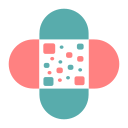 ETFLIN
Notification
ETFLIN
Notification
